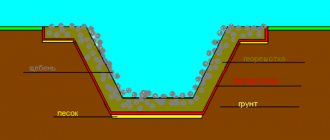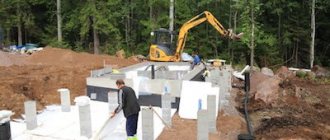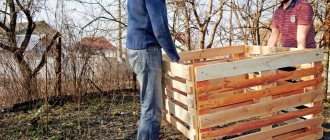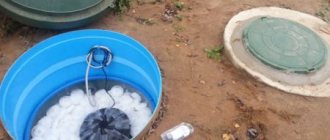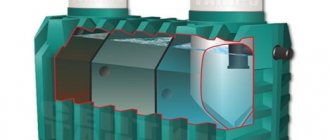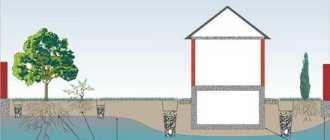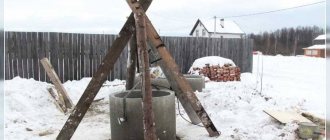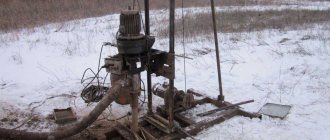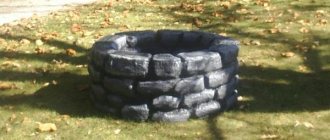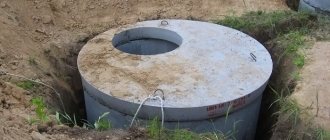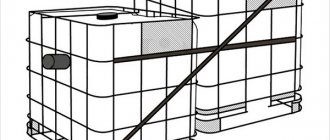- 3.1 Ventilation device for the filtration field
For private houses that are not connected to a centralized sewer system, it is necessary to install a septic tank. Its purpose is to purify wastewater and prevent dirt from entering water bodies and soil. Before starting work, you need to find out how to properly make drainage for a septic tank, based on certain conditions on your site.
A properly installed drainage system for a septic tank will extend its service life.
When setting up a septic tank, mistakes should be avoided. The consequences can be extremely undesirable - a polluted area, a broken sewer system, which, in turn, worsens the comfortable living conditions of the people living in the house. You should pay attention not only to the arrangement of the septic tank itself, but also to the construction of its other elements - the filtration field, as well as the drainage system.
Types of drainage devices ↑
Only a small portion of the wastewater treated through a septic tank ends up as solid waste. The bulk in the form of clarified liquid is discharged into the ground or a nearby body of water.
The drainage system is responsible for discharging treated wastewater into the soil.
Drainage for a septic tank can have various design solutions. Three types of drainage systems are most widely used in suburban construction:
- Filter wells are the simplest drainage option, most widely used in the construction of autonomous sewers. Wells are installed when there is an abundance of flood runoff and deep groundwater.
- Drainage fields are designed to distribute the liquid flowing from the septic tank through a network of branched pipelines. They are effective on sandy loam, loam and sandy soils, as well as in areas with high groundwater levels.
- Drainage tunnels are an advanced drainage method. The tunnels connected to each other form underground systems that are capable of receiving “portions” of up to 300 liters at a time.
When choosing a drainage method, they are guided by two parameters: the soil composition on the site and the groundwater horizon
The key factor when choosing the type of system is the cost of construction. If you can build a drainage well with your own hands, then to create filtration tunnels you will have to spend a lot of money on purchasing special equipment.
Selecting filter material: gravel or crushed stone ↑
The most frost-resistant and durable crushed stone is granite or dolomite. The gravel version looks the same, but it is made by crushing round gravel, which has a loose structure inside. The filter from it will crumble in ten years and will have to be poured out again.
A septic tank with a drainage well is a necessary system for every dacha and private house
In many ways, the choice between gravel and crushed stone when constructing a septic tank drainage well depends on the availability and cheapness of the material in a particular area. It is recommended to use crushed stone with a fraction of 2–4 cm. A larger stone is heavy, and it will be difficult to throw it with a shovel. And smaller fractions will be compressed and will not allow water to pass through.
Technology for arranging a filter well ↑
A filter well is an engineering structure in the form of an ordinary well with a shaft, but without a bottom. It is installed next to the storage tank, thereby creating a two-chamber treatment system. Purified wastewater from the storage tank of the septic tank enters the filtration well. In the well they undergo additional filtration and are discharged into the ground.
The filtering capacity of a drainage well depends on the soil composition of the area and the occupied area
Important: according to the current SNiP, the bottom of the drainage well must be at least one meter above the groundwater level.
A drainage well is the best option for arranging an autonomous sewer system for a small country cottage or a house intended for seasonal living. A simple and inexpensive structure that can easily handle small volumes of water. Filter wells can be installed not only on sandy and sandy loam soils, but also on “problem” areas with moisture-saturated soils.
Digging a pit ↑
To construct a well, dig a pit 50 cm larger in diameter than the reservoir. For a well, the daily “portion” of which does not exceed 2 cubic meters, a pit with a diameter of 1.2-1.5 meters and a depth of 1.5-2 meters is sufficient.
The bottom of the pit is leveled and lined with a layer of sand, forming a layer 30-40 cm thick.
Use coarse sand or fine granite crushed stone
The sand or granite “cushion” is designed to increase the filtering capacity of the well and prevent the destruction of the walls of the structure under the influence of soil heaving during the cold period.
Important! If there is clay soil or loam just below the bottom of the well that does not absorb moisture well, several holes must be drilled in the bottom of the pit.
Construction of walls ↑
The walls of absorption-type drainage wells can be made of different materials. For this purpose they mainly use:
- moisture-resistant brick (used will do);
- monolithic reinforced concrete;
- ready-made plastic tanks;
- industrial reinforced concrete rings.
The walls of the well are installed on the prepared and leveled base. Brick walls are built in stages, laying row after row. The blocks are not placed close to each other, due to which water will seep not only through the bottom, but also through the walls of the tank. Masonry can be done without mortar.
When using reinforced concrete blanks, the rings are simply installed at the bottom of the pit using a crane, fastening the blanks together. At a level of 50-80 cm from the bottom of the tank, the walls are perforated.
Advice: to prevent the perforations of the walls from silting, make expanded clay or gravel backfill around the circumference of the installed workpiece.
How to install reinforced concrete rings without the use of special equipment is demonstrated in the video: ↑
Insulation and ventilation ↑
The top of the well is covered with a shield made of boards, and then sprinkled with crushed stone, gravel or granulated slag.
Insulating the upper part of the tank will help prevent freezing of the drainage well in winter. For this purpose, foam or mineral wool is used. Insulation materials are simply laid in the cavity between the outer walls of the tank and the wall of the pit. Wooden panels are used as external insulation.
When installing a drainage well, as well as the septic tank itself, it is necessary to provide ventilation.
The ventilation pipe will remove gases generated as a result of the decomposition process of waste, which pose a danger to the health of households
To do this, a hole is made in the wall of the upper ring for the ventilation pipe. From the outside of the wall, a tee is mounted to the hole at an angle of 45°, and a PVC pipe with a diameter of 110 mm is connected to it.
The vertical pipe is positioned so that it rises half a meter above the ground. To protect against precipitation from entering the pipe cavity, the upper end of the pipe is equipped with a visor.
What types of drainage can there be?
- horizontal;
- vertical;
- combined.
Horizontal drainages, in turn, can be:
Open drainage system
In this case, water flows into special open ditches, trays or trenches. We can say that this is the fastest and most inexpensive method of drainage. To construct such a system, you need to dig drainage ditches of appropriate sizes.
Recommended reading: How to make a well for sewerage?
complex drainage design of the sewer system
In the process of planning a land plot, many are interested in how to properly make a drainage system. It is worth noting that we must not forget about the slopes from the house in the direction of adjacent areas, roads or drainage ditches. It is necessary to ensure conditions under which water from the roof, for example, rainwater or melting snow, will flow into dug ditches along blind areas and recesses along special paths.
Of course, this method of installing a drainage system does not look entirely aesthetically pleasing, and it may create certain inconveniences for the residents of the house. The best option for creating drainage is to use drainage trays or a closed structure.
Closed drainage
Closed drainage sewers are trenches with drainage elements located at the bottom. Earth should be poured on top of this layer.
Closed drainages can be:
- simple;
- with special trays;
- with pipe installation;
- using drainage mats.
All of the above methods are used to create linear and contour drainage systems, but this does not apply to the latter type.
Subtleties of installing filtration fields ↑
Drainage fields are structures made of a series of parallel pipelines that are located in the upper layers of the soil.
Properly designed filtration fields can further purify wastewater by another 20-30%.
Filtration fields can occupy an area from several meters to hundreds of square meters. The performance of the system directly depends on the length of the installed drains.
Construction of the dosing chamber ↑
To ensure a uniform flow of wastewater, a dosing chamber is constructed at the outlet of the septic tank. It is a tank with a capacity of up to 1 cubic meter. For its arrangement, you can use a ready-made plastic container of the appropriate volume.
A pit with an area of 1x1 meter is dug for the installation of the dosing chamber.
The bottom of the pit is leveled and the tank is immersed in it. To ensure uninterrupted operation of the system, a siphon with a diameter of 100 mm and a knee height of 200 mm is installed at the outlet of the tank. As it fills, it will self-charge and then self-empty, supplying clarified liquid to the distribution pipelines.
Laying the distribution pipeline ↑
To construct the pipeline distribution network, perforated pipes with a diameter of 75-100 mm made of asbestos cement, ceramics or polymer materials are used. The end of each pipe must be equipped with a ventilation outlet.
To construct the system in a designated area, it is necessary to dig several trenches to a depth below the soil freezing level. This indicator is different for different climatic zones. But in any case, it should be at least half a meter from the surface of the earth.
The trenches are placed at an equidistant distance of 1.5-2 meters parallel to each other
The bottom of each trench is lined with a filter layer using gravel or sand. The layer thickness should be 20-25 cm. Perforated pipes are laid at the bottom of the trench, the main task of which is to carry out distributed water discharge.
Tip: to protect the holes of perforated pipes from silting, wrap them with geotextile before laying the products.
The distribution pipeline links are connected to each other using sewer tee fittings in a checkerboard pattern.
The easiest way to calculate the total length of the trenches is to use the table
When laying pipes, it is important to maintain a slope of 2% in the opposite direction from the well in order to ensure unimpeded gravity flow of wastewater. The trenches with laid pipes are covered with a layer of gravel. To minimize the risk of damage to the drainage, platforms are laid on top of the trenches. For the same reason, it is prohibited to plant shrubs and trees near places where pipes are laid.
Video description
How to choose pipes for a drainage septic tank:
All drainage pipes for the drainage field of a septic tank must have an equal laying slope - the slope of a drainage pipe per 1 meter, the slope is 1.5 centimeters. Every 6 meters, a riser is installed for ventilation.
Sand, with a fraction of up to 10 millimeters, as well as crushed stone with a fraction of 30 millimeters, is used for laying pipelines. In addition, geosynthetics are used, namely geotextiles, which are intended for thermal insulation of pipelines. The material provides additional purification of water waste.
The pipes are “wrapped” in geotextile, sand and crushed stone - these materials trap all large inclusions and additionally protect the pipes from freezing Source infourok.ru
